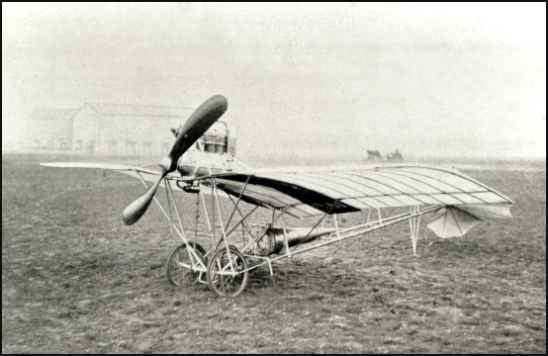
 |
The French aviator Garros taken prisoner by the Germans. Photo, text & translation courtesy of Giovanni Giorgetti, 7-8-07 |
|
IN HISTORY OF EARLY BIRDS By ERNEST JONES, EB C. G. White, in a Bleriot, won the Gordon Bennett at 62.5 miles in 1 hour 1 minute 1 second. Leblanc, in a Bleriot, made a flock of world records over distances ranging from five to 90 kilometers. His greatest speed was 109.23 kph. Hamilton was unofficially timed at 107 kph. Johnstone and Hoxsey made approximately 8,000 and 7,000 feet respectively in a high wind which drove them backward, 42 and 25 miles respectively. Moisant, in a Bleriot, won the $10,000 Allan Ryan Statue of Liberty prize race, which was contested by White and finally awarded to DeLesseps, who finished last. There were more foreign contestants than ever before or since, more new records established and the exhibitions were relatively speaking, more spectacular. Following were the contestants: |
|
Then there were Walter Brookins, Arch Hoxsey, J. C. Turpin, Ralph Johnstone, P. O. Parmalee, all Americans, with Wright machines; Alec Ogilvie (England), Wright; Todd Shriver (America), Curtiss; J. J. Frisbie (America), Curtiss type. Walter Christie had a monoplane with two tandem engines, but it was not flown. Harkness did not fly but Latham flew his Antoinettes for him and distinguished himself, along with Hoxsey and Johnstone, by flying in high winds when the rest of the pilots were grounded. courtesy of Steve Remington - CollectAir |
 |
Library of Congress Collection 7-12-07 |
|
Daily Journal and Tribune, Knoxville, Tennessee: November 28, 1910, Transcribed by Bob Davis - 11-18-03 The program for the three days' meet includes speed, altitude, distance, duration and cross-country flying. There will also be a race every day between an aeroplane and an automobile. Garros, in his Demoiselle, will at times appear against a local motorist, and Charles K. Hamilton will every afternoon of the meet race his 110 horsepower Fiat Vanderbilt cup racer, the distance for two of the days to be five miles and the third day to be ten miles." Bob Davis |
|
Extract from Revolución Mexicana / Contrarrevolución en Yucatan" Vol 61, October 1967 Courtesy of Gerardo Garcia de León |
| En el mes de marzo de 1911, arribó procedente de Francia una compañia de aviación, organizada por el señor Alfredo B. Moissant, la que en presencia del Gral. Porfirio Diaz, presidente de la República, y a instancias del ministro de Guerra, puso a prueba la utilidad del aeroplano para fines militars de observación. Para tal efecto se ocultaron tropas en las proximidades del cerro de la Estrella, que se encuentra en al Valle de México. siendo descubiertas fácilmente por el aviador Roland Garros. |
|
via email from Dave Lam, 4-1-05 Roland Garros got his French license, # 147, on 19 July 1910 in a Demoiselle. Dave |
|
Eclipses Old record by 2,461 Feet Engine Stops Suddenly, The Daily Times Chattanooga, Tennessee, September 7, 1912, Roland G. Garros, the aviator, today eclipsed the old world's record for altitude by about 2,461 feet. Ascending in a monoplane Garros went up 16,240 feet. At this height the rarified atmosphere caused the engine to stop suddenly and the aviator had to volplane to the ground. The previous record of 13,799 feet was made at Vienna, June 29, by the Austrian aviator Czakay. In the flight the Austrian carried a passenger.. |
 |
|
Collection of Jean-Pierre Lauwers |
|
The next Dumont airplane was the XIX, the famous Demoiselle, a baby tractor
monoplane with two-cylinder opposed air-cooled Dutheil-Chalmers engine of 17-20 h.p., with elevator forward just ahead of the chassis
on a level with the axle. The wings had a sharp dihedral angle. Vertical lozenge-shaped panel on each side of chassis and a universally
mounted cruciform tail. November 16, 1907---With this machine were made flights of 200m., 100m. and 200m. at Issy on November 17, among others. March 1908---Experiments were made with Dumont's sixteenth aircraft, a machine with two engines of low power. October 1908---A new Demoiselle was flown at Issy similar to above but with forward elevator omitted and with an Antoinette 24 h.p. engine. In November it was flown at St. Cyr. Flights were continued at various times through 1909, including the FIRST CROSS-COUNTRY flight one of about eight kils., from St. Cyr to Buc on September 13, returning the following day, and another on the seventeenth, of 18 kils. in 16 mins. Dumont's name was not thereafter prominently connected with aeronautics. The Demoiselle, fitted with two-cylinder engine, became rather popular. It was flown by Audemar and Roland Garros at the Belmont Park, New York, meet in 1910 and facsimiles and parts therefor were sold by American supply concerns for several years thereafter. |


|